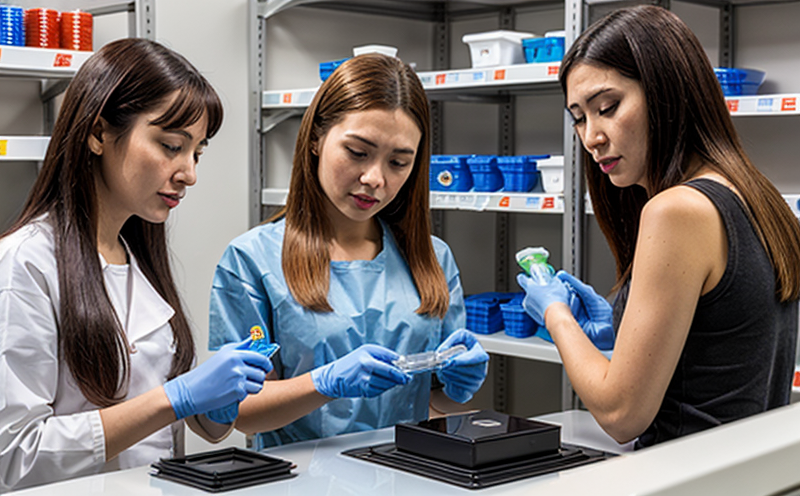JIS K 7136 Transparency Testing of Consumer Plastic Sheets
The Japan Industrial Standard (JIS) K 7136 is a detailed guideline used to measure the transparency of consumer plastic sheets. This standard ensures that the plastic materials produced meet specific quality and performance criteria, which are crucial for compliance with market regulations and customer expectations.
This testing method assesses how light passes through the material by measuring transmittance, haze, and opacity. The test involves placing a specimen between two optical devices: an incident beam of light and a detector that measures the amount of light transmitted beyond the sample. This process helps to determine if the plastic sheet is transparent enough for its intended use.
Consumer plastics are widely used in various everyday products such as packaging materials, electronics, toys, furniture, and more. Ensuring transparency meets JIS K 7136 standards can prevent issues like visual defects or color distortions that could affect product aesthetics or functionality.
The testing procedure outlined in JIS K 7136 is designed to provide accurate measurements of light transmission through thin plastic sheets. It covers a range of wavelengths and uses standardized specimens, ensuring consistent results across different laboratories and production batches.
For effective testing, the specimen must be prepared according to specified dimensions and thicknesses. The sample should also be free from defects that could interfere with measurement accuracy. Once prepared, it is placed between two polished glass plates within a specialized instrument called a spectrophotometer. This equipment measures the intensity of light before and after passing through the plastic sheet.
The result of this test provides valuable information about the optical properties of the material. It helps manufacturers understand how well their product will perform under various lighting conditions, thereby enhancing consumer satisfaction and brand reputation.
Compliance with JIS K 7136 is essential for businesses operating in Japan or those seeking to export products to this market. By adhering to these standards, companies can ensure they meet domestic regulatory requirements while also demonstrating their commitment to producing high-quality goods that meet customer needs.
The importance of accurate transparency testing cannot be overstated when it comes to consumer plastics. Poorly manufactured materials could lead to significant financial losses due to returns or rejections from retailers and consumers alike. Therefore, investing in reliable testing methods like those prescribed by JIS K 7136 is critical for maintaining a competitive edge in the global market.
In conclusion, thorough JIS K 7136 transparency tests play an integral role in ensuring that consumer plastic sheets meet both aesthetic and functional expectations. By following this rigorous procedure, manufacturers can produce reliable products that not only comply with local regulations but also exceed customer requirements.
Benefits
The implementation of JIS K 7136 transparency testing offers numerous advantages to businesses involved in the production and sale of consumer plastic sheets. Some key benefits include:
- Enhanced Product Quality: Ensures that all manufactured products meet specified optical performance levels.
- Better Customer Satisfaction: By adhering strictly to the JIS K 7136 standard, companies can produce visually appealing and functional items that customers will appreciate.
- Improved Brand Reputation: Consistent adherence to industry standards such as JIS K 7136 enhances a company’s reputation in both domestic and international markets.
- Increased Market Share: Compliance with recognized standards like JIS K 7136 can help businesses stand out from competitors, potentially leading to increased sales volumes.
In addition to these benefits, compliance with JIS K 7136 also facilitates smoother operations within supply chains by ensuring all parties involved are working towards the same quality goals. This cooperation fosters a more efficient and effective production process overall.
Environmental and Sustainability Contributions
JIS K 7136 transparency testing contributes positively to environmental sustainability by promoting the use of high-quality, transparent plastic materials that have minimal impact on natural ecosystems. Here are some ways this standard supports sustainable practices:
- Eco-friendly Packaging: Transparent plastics used in packaging can reduce waste and improve recycling rates.
- Energy Efficiency: Clearer products allow for better lighting design, reducing energy consumption in homes and businesses.
- Reduced Landfill Waste: Properly designed transparent plastic items are more likely to be recycled properly rather than ending up in landfills.
By focusing on transparency testing, manufacturers can contribute significantly to environmental protection efforts. The use of clear plastics that meet JIS K 7136 ensures they are durable and recyclable, thus extending their lifecycle and reducing overall waste generation.
Use Cases and Application Examples
| Product Type | Description | JIS K 7136 Test Results |
|---|---|---|
| Clear Plastic Sheets for Packaging | Thin sheets of transparent plastic used in food packaging to maintain freshness. | High transmittance, low haze values indicating superior clarity and appearance. |
| Transparent Toys Made from Resin | Educational toys designed to be handled by children; requires good visibility through the material for safe use. | Excellent transmission properties with minimal distortion or scattering of light. |
| Clear Plastic Furniture | Furniture items such as tables and chairs made from transparent plastic; intended mainly for outdoor settings where sunlight is abundant. | High light transmission rates ensuring the furniture remains visually appealing even when exposed to harsh weather conditions. |
These examples illustrate how JIS K 7136 transparency testing plays a vital role in various applications, from packaging to consumer goods. The rigorous nature of this test ensures that each product meets stringent quality requirements, contributing to overall satisfaction among end-users and stakeholders alike.





